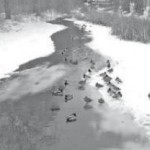The remaining wetlands in Kelowna cover just one per cent of the city’s land base.
It’s estimated that 85 per cent of the wetlands in the Central and South Okanagan have been lost due to agriculture and other development.
Kyle Hawes, of Ecoscape Environmental Consultants, reported at the Status of Central Okanagan Watershed workshop Friday on Kelowna’s wetlands, calling them “some of the rarest and yet most biologically significant and diverse communities in Kelowna.”
Yet many of those remaining are fragmented and poorly functioning.
More than 80 per cent of species are dependent on wetlands and riparian areas for a part of their life cycle, he noted.
Despite this recognition of their importance, wetlands continue to be lost, he said.
And, 74 per cent of the remaining wetlands have been “modified,” while only 24 per cent are natural and two per cent are constructed wetlands.
Many are isolated rather than linked and 46 per cent are shallow water, while 28 per cent are marsh, 23 per cent swamp, two per cent meadow and one per cent riparian.
He said 50 per cent have three vegetation communities on them, while 43 per cent are open water types.
“There are only a few very diverse ones,” he noted.
Wetland size doesn’t matter. Size and structure are poor indications of amphibian richness, he noted.
As well, people often overlook the importance of invertebrates as food for birds and fish when looking at a wetland.
As a result of the inventory of Kelowna’s wetlands which Ecoscape is completing, they’ve found that 56 per cent are at risk, 40 per cent function properly and four per cent are non-functioning.
However, there are opportunities for restoration, he said.
While reed canary grass is important in some ecosystems, it can displace other plant communities and become invasive. It’s common in Kelowna wetlands, noted Hawes.
Yellow iris and purple loosestrife are other alien invaders which can take over wetlands, choking out everything else.
Hawes advises land use planning should focus on protecting and restoring wetland communities in Kelowna; minimize hydrological changes and avoid fragmentation.
Buffers should be established and maintained around wetlands.
Wetlands are dynamic ecosystems which do change over time, he warned, so consideration also needs to be given to protect the current state of the remaining wetlands, or they could be lost to natural processes such as infill from accumulations of decayed plant matter and sediments.
Environment supervisor Todd Cashin says now that the city’s wetlands have been identified, work is underway to protect them.
“We are updating our Official Community Plan maps to ensure they’re identified on them,” Cashin said.
When the OCP is updated, he says they hope to go to council to ensure wording is included to protect what’s left.
The Regional Growth Strategy’s goal is to plan for development, to know what needs to be protected, and then to protect it.
It also details what ought to be protected, including riparian areas and wetlands.

